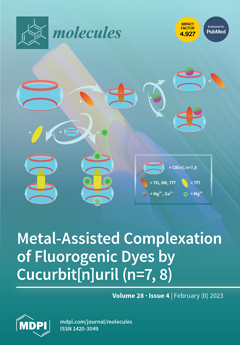With overexpression in various cancers, the gastrin-releasing peptide receptor (GRPR) is a promising target for cancer imaging and therapy. However, the high pancreas uptake of reported GRPR-targeting radioligands limits their clinical application. Our goal was to develop
68Ga-labeled agonist tracers for detecting
[...] Read more.
With overexpression in various cancers, the gastrin-releasing peptide receptor (GRPR) is a promising target for cancer imaging and therapy. However, the high pancreas uptake of reported GRPR-targeting radioligands limits their clinical application. Our goal was to develop
68Ga-labeled agonist tracers for detecting GRPR-expressing tumors with positron emission tomography (PET), and compare them with the clinically validated agonist PET tracer, [
68Ga]Ga-AMBA. Ga-TacBOMB2, TacBOMB3, and TacBOMB4, derived from [Thz
14]Bombesin(7–14), were confirmed to be GRPR agonists by a calcium mobilization study, and their binding affinities (K
i(GRPR)) were determined to be 7.62 ± 0.19, 6.02 ± 0.59, and 590 ± 36.5 nM, respectively, via in vitro competition binding assays. [
68Ga]Ga-TacBOMB2, [
68Ga]Ga-TacBOMB3, and [
68Ga]Ga-AMBA clearly visualized PC-3 tumor xenografts in a PET imaging study. [
68Ga]Ga-TacBOMB2 showed comparable tumor uptake but superior tumor-to-background contrast ratios when compared to [
68Ga]Ga-AMBA. Moreover, [
68Ga]Ga-TacBOMB2 and [
68Ga]Ga-TacBOMB3 showed a much lower rate of uptake in the pancreas (1.30 ± 0.14 and 2.41 ± 0.72%ID/g, respectively) than [
68Ga]Ga-AMBA (62.4 ± 4.26%ID/g). In conclusion, replacing Met
14 in the GRPR-targeting sequence with Thz
14 retains high GRPR-binding affinity and agonist properties. With good tumor uptake and tumor-to-background uptake ratios, [
68Ga]Ga-TacBOMB2 is promising for detecting GRPR-expressing tumors. The much lower pancreas uptake of [
68Ga]Ga-TacBOMB2 and [
68Ga]Ga-TacBOMB3 suggests that [Thz
14]Bombesin(7–14) is a promising targeting vector for the design of GRPR-targeting radiopharmaceuticals, especially for radioligand therapy application.
Full article






